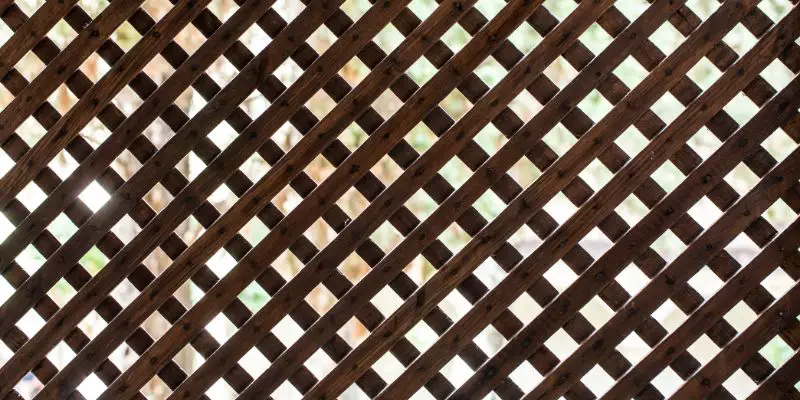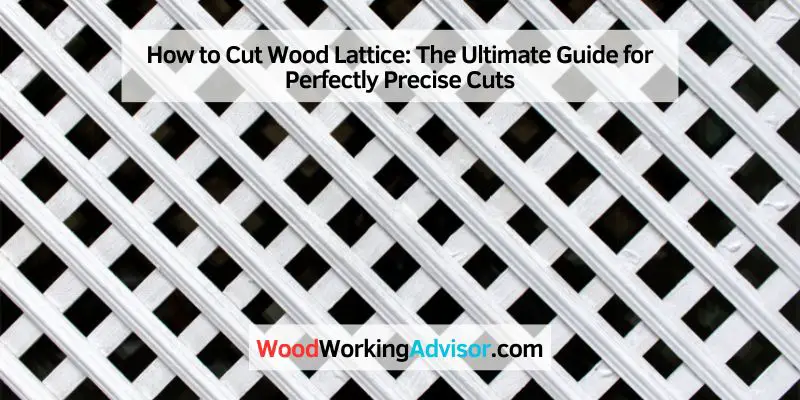To cut a wood lattice, measure and mark the desired length and use a saw to carefully cut along the marked line. Lattice cutting requires accurate measurements and a clean, precise cut using a saw.
Are you wondering how to cut wood lattice for your next woodworking project? Cutting lattice can seem like a daunting task, but with the right tools and technique, it is easier than you might think. Whether you are building a fence, installing a privacy screen, or creating a decorative element, cutting the lattice to the correct size is crucial for a professional-looking finish.
In this guide, we will walk you through the step-by-step process of cutting wood lattice. From measuring and marking the correct length to making a clean cut with a saw, we will cover all the essential tips and tricks for successfully cutting wood lattice. So let’s get started and make your woodworking project a success!
Choosing The Right Tools
Cutting wood lattice may seem like a daunting task, but with the right tools, it can be a breeze. In this section, we will discuss the key factors to consider when choosing the tools for cutting wood lattice. From selecting the saw to considering blade types, we’ve got you covered.
Selecting The Saw
One of the most important decisions you’ll make when cutting wood lattice is selecting the right saw. A saw that is not well-suited for the task can result in inaccurate cuts or even damage to the lattice itself. There are different types of saws available, each with its own unique features and capabilities. Here are a few options to consider:
- Circular Saw: This versatile tool is perfect for making straight cuts in wood lattice. Its circular blade spins rapidly, allowing for precise and efficient cuts. Make sure to choose a circular saw with a fine-toothed blade for smoother cuts.
- Jigsaw: If you require more intricate cuts or curved patterns, a jigsaw may be the ideal choice. Its thin, reciprocating blade moves rapidly up and down, allowing for greater flexibility when cutting wood lattice.
- Hand Saw: For smaller projects or quick touch-ups, a hand saw can be an excellent option. Its compact size and maneuverability make it easy to handle, although it may not deliver the same level of precision as power tools.

Considering Blade Types
Once you’ve selected the right saw, it’s crucial to consider the blade type that will suit your wood lattice-cutting needs. The blade you choose will determine the quality, speed, and accuracy of your cuts. Here are a few blade types to consider:
| Blade Type | Suitable for | Advantages |
|---|---|---|
| High TPI (Teeth per Inch) | Finishing cuts on wood lattice | Produces smooth, clean edges. Ideal for fine woodworking. |
| Low TPI | Rip cuts on wood lattice | Removes material quickly. Suited for rough cuts on thicker wood. |
| Bimetal Blade | General-purpose cutting on wood lattice | Offers both durability and versatility. Suitable for a wide range of cutting tasks. |
By considering the saw and blade types, you’ll ensure that your wood lattice-cutting experience is efficient and satisfying. The right tools will help you achieve precise cuts, whether you’re working on a small project or a larger installation. Now that you’ve got these essentials covered, it’s time to move on to the next step: measuring and marking your wood lattice for accurate cuts.
Measuring And Marking
Before you start cutting wood lattice, properly measuring and marking the cut line is essential. By following these steps, you can ensure accurate and precise cuts that will fit seamlessly into your project.
Measuring The Lattice
The first step in cutting wood lattice is to measure the piece you need. Start by determining the length of the lattice you require. Use a measuring tape to measure from one end of the area to the other, ensuring a snug fit. Measure the width of the lattice as well, taking into account any gaps or overlaps you may need.
Once you have your measurements, add a small buffer to each side to allow for any adjustments or mistakes during the cutting process. It is always better to have a slightly larger piece of lattice that you can trim down if needed rather than cutting too small and needing to start over.
Marking The Cut Line
After measuring the lattice, the next step is marking the cut line. This ensures that your cuts are precise and that the lattice will fit perfectly into your project.
Using a straight edge, such as a ruler or a level, draw a straight line across the lattice where you intend to make the cut. For longer cuts, it may be helpful to use a long, straight board as a guide to ensure a straight line throughout the entire length of the lattice.
If you need to make multiple cuts, mark each cut line separately to avoid confusion. Double-check your measurements and cut lines before moving on to the cutting process. Taking the time to measure and mark accurately will save you time and prevent frustration in the long run.
Now that you have measured and marked your wood lattice, you are ready to move on to the next step in the cutting process. Keep in mind that careful measuring and precise marking are crucial in achieving the best results for your project.
Making The Cut
When it comes to working with wood lattice, knowing how to make precise cuts is crucial for achieving a professional-looking finish. In this guide, we’ll delve into the details of making the cut when working with a wood lattice to enhance your woodworking skills. Here are the essential steps to help you achieve clean and accurate cuts.
Setting Up The Work Area
Before beginning any cutting, it’s essential to set up a suitable work area. Start by clearing out a well-lit, spacious space where you can comfortably maneuver the lattice material. Ensure the area is clean and free from obstructions to avoid accidents and facilitate smooth cutting.
- Clear the workspace of any clutter or obstacles to ensure seamless movement of the lattice material.
- Use a workbench or sturdy surface to support the lattice piece and prevent unnecessary movement during cutting.
- Have all the necessary tools and safety equipment within arm’s reach to enhance efficiency and promote safety.
Using Proper Cutting Techniques
The key to achieving precise cuts on wood lattice lies in using the proper cutting techniques. Here are the steps to ensure accurate and clean cuts:
- Measure and mark the cut line accurately using a straight edge and a pencil.
- Secure the lattice material firmly to prevent any unintended movement during cutting.
- Use a sharp and fine-toothed saw to cut through the lattice material, applying gentle and consistent pressure.
- Take your time and maintain a steady hand to ensure the cut follows the marked line accurately.
Fine-tuning The Edges
Fine-tuning the edges of your wood lattice is an important step to ensure a polished and professional finish. By smoothing rough edges and applying finishing touches, you can create a lattice that not only enhances the aesthetic appeal of your space but also improves its overall functionality. In this article, we will explore two key aspects of fine-tuning the edges: smoothing rough edges and applying finishing touches.
Smoothing Rough Edges
If you’ve just cut your wood lattice, chances are you have some rough edges that need attention. Smoothing these edges is essential for a clean and neat appearance. Here are a few steps to get the job done:
- Start by using a sanding block or sandpaper with fine grit to gently rub the rough edges. Make sure to move the sanding block or sandpaper along the edges in a smooth and consistent motion.
- After sanding, use a damp cloth to wipe away any dust or debris that may have accumulated on the surface of the lattice.
- If necessary, repeat the sanding process until the edges are smooth to the touch.
- Inspect the edges for any remaining rough spots. If you find any, sand those areas again until they are completely smooth.
Applying Finishing Touches
Once you’ve smoothed the rough edges, it’s time to apply a few finishing touches to give your wood lattice a polished look. Here are some steps to consider:
- Round the edges: Using a router with a round-over bit, carefully round the edges of the lattice. This not only adds a decorative touch but also helps prevent splintering.
- Stain or paint: Depending on your preference, you can choose to stain or paint the wood lattice. Ensure you use a high-quality stain or paint that is suitable for outdoor use to protect the wood from weather elements. Apply the stain or paint evenly, following the manufacturer’s instructions.
- Seal the wood: To further protect your wood lattice, consider applying a clear sealant. This will help preserve the wood and extend its lifespan, ensuring your lattice stays looking new for years.
Safety Precautions
When cutting wood lattice, always wear protective gloves and safety goggles. Secure the lattice firmly in place before making any cuts. Use a sharp saw and cut slowly and steadily to avoid splintering or accidents. Always prioritize safety and take precautionary measures to prevent injuries.
Wearing Protective Gear
When working with wood lattice, it is vital to prioritize your safety. Wearing protective gear can greatly reduce the risk of injuries and accidents. Here are the essential items you should have:
- Safety Glasses: Protect your eyes from flying debris, dust, and wood chips.
- Dust Mask: Prevent inhalation of sawdust particles, which can irritate your lungs.
- Ear Protection: Guard against loud noises generated by power tools.
- Gloves: Provide a secure grip on tools and protect your hands from splinters.
- Long-sleeved Shirts and Pants: Cover your skin to avoid cuts and scratches.
By ensuring you have the appropriate protective gear, you can proceed with cutting wood lattice safely and effectively.
Securing The Workpiece
Before cutting the wood lattice, it is crucial to properly secure the workpiece. This prevents it from shifting or moving, reducing the risk of accidents. Here’s how you can secure the wood lattice:
- Clamps: Use clamps to firmly hold the wood lattice in place on a stable workbench or sawhorse.
- Double-Sided Tape: Apply double-sided tape to the back of the lattice to keep it secure on the work surface.
- Workbench Vise: If available, use a workbench vise to hold the wood lattice firmly in position.
By taking the time to secure the workpiece, you can operate your tools with confidence, minimizing the likelihood of accidents and achieving more precise cuts.

Frequently Asked Questions Of How To Cut Wood Lattice
What Is The Best Tool For Cutting Wood Lattice?
The best tool for cutting wood lattice is a jigsaw. It is efficient, precise, and easy to use for making accurate cuts. The jigsaw provides clean and smooth edges, making it ideal for shaping and cutting lattice panels.
What Is The Easiest Way To Cut Lattice?
The easiest way to cut lattice is by using a handsaw or a circular saw. Measure the dimensions, mark the cut lines, then carefully cut along the lines using a saw. Make sure to wear safety goggles and gloves while cutting lattice.
Can I Cut Wood Lattice With a Hand Saw?
Yes, you can cut wood lattice with a hand saw. Use a sharp, fine-toothed saw for clean cuts. Take your time to ensure accuracy and safety.
How Do You Cut Trellis?
To cut the trellis, follow these steps:
1. Gather necessary tools like pruning shears or a handheld saw.
2. Assess the trellis and identify the branches to be cut.
3. Position yourself safely and make clean cuts at a 45-degree angle.
4. Remove any excess or dead branches.
5. Regularly maintain and trim to ensure the trellis remains healthy and tidy.
Conclusion
To conclude, cutting wood lattice can be a straightforward task with the right tools and techniques. By following the step-by-step guide provided you can achieve precise and clean cuts for your woodworking projects. Remember to prioritize safety and take the time to measure accurately to ensure professional-looking results.
Happy cutting!


